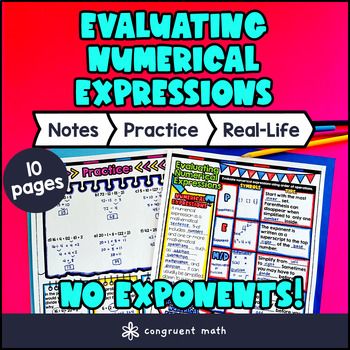Want more ideas and freebies?
Get my free resource library with digital & print activities—plus tips over email.
Join for Free Resources →
$4.25
Ever wondered how to teach evaluating numerical expressions of positive numbers (without exponents) in an engaging way to your 5th-grade or 6th-grade students?
In this lesson plan, students will learn about numerical expressions, order of operations, and their real-life applications. Through artistic, interactive guided notes, check for understanding, a practice coloring worksheet, and a maze activity, students will gain a comprehensive understanding of evaluating numerical expressions.
The lesson ends with a real-life example that explores how numerical expressions are used in practical scenarios, fostering a deeper connection between the math concept and its application in the real world.

$4.25
After this lesson, students will be able to:
Before this lesson, students should be familiar with:
As a hook, ask students why understanding how to evaluate numerical expressions is important in everyday life. Refer to the last page of the guided notes focusing on real-life applications, as well as the FAQs below for ideas.
Use the first page of the guided notes to introduce the concept of evaluating numerical expressions without exponents. Walk through the order of operations (PEMDAS) and emphasize the importance of parentheses, brackets, and braces in numerical expressions. Point out key examples and guide students through solving expressions step by step.
Have students work on the practice problem sets on the second page of the guided notes. Refer to the FAQ below for a walk through on this introduction, including strategies for engaging students and addressing common questions or misconceptions.
Based on student responses during the introduction, reteach any concepts that students may struggle with. If there is a wide range of proficiency levels in the class, consider pulling out groups of students for additional support while more advanced students can begin working on the practice exercises.
Have students practice evaluating numerical expressions using the engaging maze activity included in the guided notes (pg. 3). Students should solve problems involving parentheses, brackets, or braces in numerical expressions and evaluate the expressions following PEMDAS. In this guided notes, no exponents are used. Circulate the room to address any student questions as they work through the problems.
Fast finishers can move on to the color by number activity included in the resource (pg. 4). You can also assign this activity as homework for students who finish early or need extra practice.
Using the last page of the guided notes, bring the class back together, and introduce the concept of evaluating numerical expressions in real-world scenarios. Discuss how understanding and applying the order of operations (PEMDAS) can help in solving practical problems involving calculations where the correct sequence is crucial. You can refer to the FAQ section for more ideas on how to creatively incorporate real-life applications of numerical expressions in your teaching.
If you’re looking for digital practice for writing numerical expressions, try my Pixel Art activities in Google Sheets. Every answer is automatically checked, and correct answers unlock parts of a mystery picture. It’s incredibly fun, and a powerful tool for differentiation.
Here’s one activity to explore:
Chain Reaction is a zero-prep activity where students work to find the solution to the current problem — which reveals the next problem on the chain. Students continue solving all the problems to reach the end of the chain. A small self check is built in per level — if their math is correct, the ending number should match their last solution.
A fun, no-prep way to practice writing numerical expressions is Doodle Math — they’re a fresh take on color by number or color by code. It includes multiple levels levels of practice, perfect for a review day or sub plan.
Here are 1 activities to try:
The order of operations, also known as PEMDAS, is a set of rules to determine the sequence in which operations should be performed within an expression.
Parentheses in numerical expressions indicate that the operations inside them should be performed first.
Brackets and braces are also used to group parts of an expression together and affect the order of operations.
Following the order of operations ensures that mathematical expressions are evaluated correctly and consistently.
Educators can integrate doodles and coloring activities to make learning engaging and provide visual representations of mathematical concepts.
Get my free resource library with digital & print activities—plus tips over email.
Join for Free Resources →